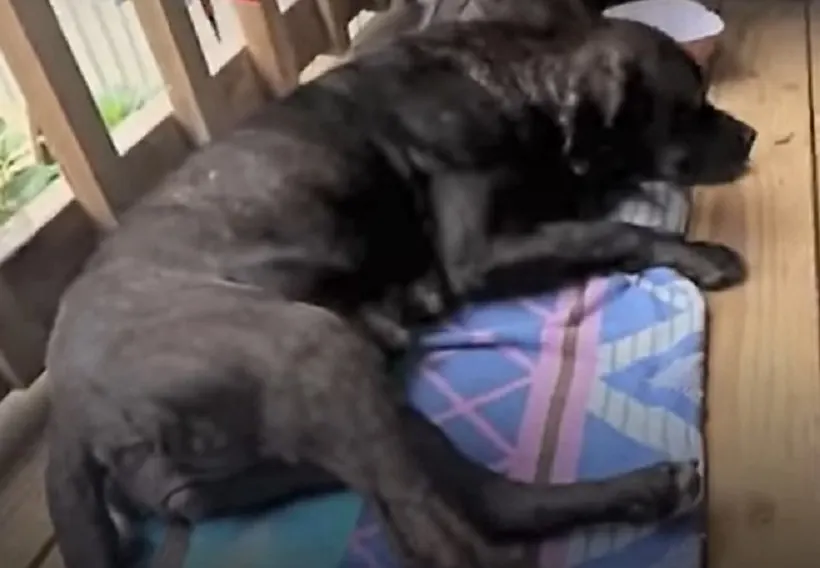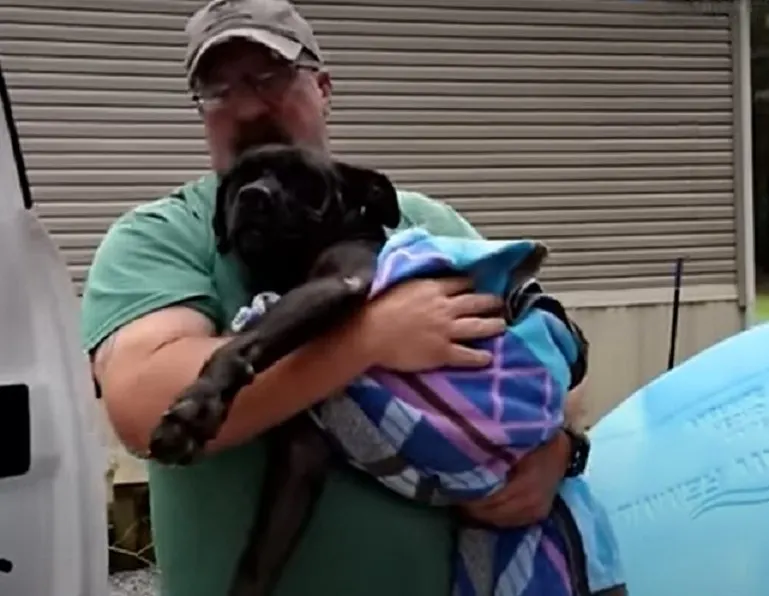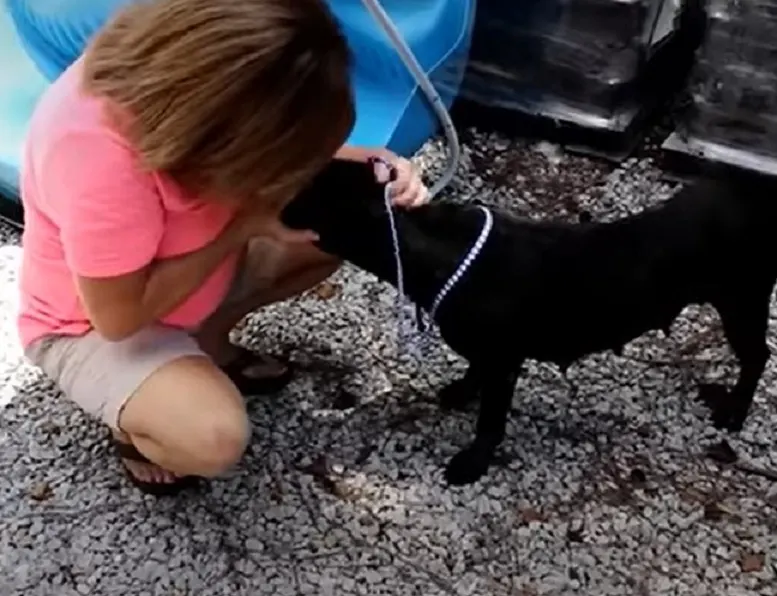While stray pups wander the streets, their hearts flicker with hope that their luck will soon change.
Their greatest wish is to find a place to call home and have a family who will love them and make them feel safe.
Betsy was one of those strays who longed to feel loved and cared for. It was something she craved for all her life.
After she got hurt one day, she knew she had to ask humans to help her. As she walked around the neighbourhood, her heart led her to the doorstep of a family whom she had never seen before.
Tired and injured, she curled up in front of their house, hoping that they would help her.
Hoping To Meet Good Humans

When April and Joe Sullivan opened their front door, they were surprised to find a black dog lying on their porch. The first thing they noticed was the sad look in her eyes. The pooch looked as if she was about to give up on herself.
The Sullivans stroked the dog and tried to make her feel better. They felt heartbroken when they realized that the doggo was injured, and that she was unable to walk on her own.
The couple’s granddaughter was there, too. Joe always taught her to be cautious around pups she didn’t know, but from the beginning, it was clear that they could let their guard down in front of sweet Betsy.
“…There was something about Betsy. Even as sick as she was, [she] bent down to pet her, she was licking her. She was nothing but… just sweet,“ said April.
Their granddaughter’s heart melted after seeing that Betsy liked her. She was enchanted with the delightful pooch and couldn’t stop looking at her.
Betsy Gets The Help And Care She Needs
As soon as the family fed Betsy, they decided to take her to the vet. Joe gently took her in his arms. While he carried her to his car, he gave her a loving kiss. The doggo felt safe.
Joe and April didn’t know how Betsy got injured, but they assumed that she had been hit by a car. They also knew that the pup would need a permanent home after she recovered.
Once Betsy received a full veterinarian checkup, the vet informed the Sullivanfamily that she had nerve damage and that she would need a lot of care.
Joe took Betsy home. He and his wife cared for her and cuddled her. They made sure she knew how much they loved her.
Getting The Love She Craved

Betsy was very affectionate and grateful for all the love and care the family gave her. She licked their faces and gave them sweet kisses. She was letting them know that she loved them, too.
The loving canine stole April’s heart, and the couple decided that Betsy would stay in their home forever. Joe admitted that he wanted to keep Betsy ever since he saw her. He was just looking for a way to make it work.
The family’s other dogs usually don’t get along with other pups, but they accepted Betsy into their pack.
“Our dogs typically don’t like other dogs. She loves our dogs. They don’t love her as much as she loves them, but they have all gotten along so well and that’s not normal for our dogs,” said April.
Thanks to her family’s excellent care, Betsy made an extraordinary recovery. She can go up and down the stairs all by herself.
The Sullivans were thrilled to see that Betsy transformed into a happy pooch who loved life.
Knowing that Betsy’s greatest wish came true makes me feel overjoyed. She deserved to be showered with the love that she lacked while living on the streets. Betsy will never be left alone again.
I hope that all stray pups will get rescued from the streets, and that they will find their way to their forever home. All stray dogs are equally worthy of feeling loved and cherished.
If you’ve noticed your female dog leaking brown fluid from her anus, it can be concerning and puzzling. As a seasoned dog trainer, I understand how important it is to address these health issues promptly. This unexpected leakage may indicate an underlying problem that needs attention. Understanding the possible reasons behind this occurrence is crucial for your dog’s well-being and your peace of mind. Dogs communicate through their behaviors, and this is one way your furry friend might be signaling that something isn’t quite right. In the following article, we’ll explore some common reasons why your female dog could be experiencing this issue. Stay tuned to learn more about how to best support your canine companion’s health and happiness.
Understanding Anal Sac Issues in Female Dogs
The Role of Anal Sacs
Anal sacs, also known as anal glands, play a vital role in a dog’s communication and marking behavior. These small glands are located near the anus and secrete a strong-smelling fluid that helps dogs mark their territory and communicate with others. Normally, the sacs empty when a dog defecates, but issues can arise when they become blocked or infected.
Common Symptoms of Anal Sac Problems
If your female dog is leaking brown fluid from her anus, it could be a sign of anal sac problems. Common symptoms include scooting or dragging her bottom along the ground, excessive licking or biting of the anal area, foul odor coming from the rear end, and discomfort or pain when sitting or defecating. It’s essential to address these symptoms promptly to prevent further complications and ensure your dog’s comfort and well-being.
Causes of Brown Fluid Leakage
Anal Sac Impaction and Infection
When your female dog is leaking brown fluid from her anus, one common cause could be anal sac issues. Anal sacs are scent glands located on either side of the anus that can become impacted or infected. When these sacs are blocked or inflamed, they can leak foul-smelling brown fluid. It’s essential to have your dog checked by a veterinarian to address this issue promptly.
Anal Gland Tumors
Another potential cause of brown fluid leakage in female dogs is the presence of anal gland tumors. These tumors can lead to abnormal secretions, including brown fluid, and may require medical intervention for diagnosis and treatment. If you notice any unusual discharge from your dog’s anus, consulting with a vet is crucial to determine the underlying cause.
Other Potential Causes
In some cases, brown fluid leakage in female dogs can be attributed to other factors such as dietary issues, allergies, or gastrointestinal problems. Changes in diet, exposure to new allergens, or underlying health conditions can also result in abnormal anal discharge. It’s important to monitor your dog’s symptoms closely and seek professional advice to identify and address the root cause of the issue promptly.
Diagnosing the Issue
Physical Examination
When dealing with your female dog leaking brown fluid from the anus, a physical examination by a veterinarian is the first step in diagnosing the issue. During this examination, the vet will assess your dog’s overall health and specifically focus on the anal area to check for any signs of infection, impaction, or other abnormalities.
Diagnostic Testing
To further investigate the cause of the brown fluid leakage, diagnostic testing may be recommended by the veterinarian. This could include procedures like a fecal examination to check for parasites or infections, an anal gland expression to evaluate the anal sacs, or even blood tests to rule out other underlying health issues. These tests are crucial in pinpointing the precise reason behind the abnormal anal discharge and guiding appropriate treatment options for your furry friend.
Treatment Options for Anal Sac Disorders
Home Care and Diet Adjustments
When dealing with anal sac disorders in your female dog, home care and diet adjustments can play a crucial role in managing the condition. Regularly expressing the anal glands is a key aspect of home care to prevent impaction and infection. You can learn this technique from your veterinarian or opt for professional help. Incorporating more fiber into your dog’s diet can help regulate bowel movements and promote natural emptying of the anal sacs. High-quality dog foods with balanced nutrition can also contribute to overall gut health and reduce the risk of anal gland issues. Monitoring your dog’s water intake is essential to ensure adequate hydration, which supports proper digestion and bowel function.
Medical Interventions
In more severe cases of anal sac disorders, medical interventions may be necessary to alleviate symptoms and address the underlying issues. Your veterinarian may prescribe antibiotics to treat infections and reduce inflammation in the anal sacs. Pain medication can help alleviate discomfort and improve your dog’s quality of life during the healing process. Topical treatments, such as medicated wipes or ointments, may be recommended to soothe the affected area and promote healing. Regular follow-up appointments with your vet are important to monitor progress and make any necessary adjustments to the treatment plan.
Surgical Procedures
In certain instances where conservative treatments are ineffective or the condition is recurrent, surgical procedures may be considered to resolve anal sac disorders in female dogs. Surgical drainage of the anal sacs may be performed to remove impacted material and facilitate proper healing. Surgical removal of the anal sacs, known as anal sacculectomy, is reserved for severe cases or persistent issues that do not respond to other treatments. Your veterinarian will discuss the risks and benefits of surgical intervention, taking into account your dog’s overall health and well-being. Post-operative care is crucial to ensure a smooth recovery process and minimize any potential complications.
Ensuring that your female dog receives the appropriate treatment for anal sac disorders is essential for her comfort and overall health. By following a comprehensive treatment plan that includes home care, medical interventions, and surgical options when necessary, you can effectively manage anal sac issues and improve your dog’s well-being. Remember to consult your veterinarian for personalized guidance tailored to your dog’s specific needs and condition.
Preventing Anal Sac Issues
Regular Grooming and Health Checks
To prevent anal sac issues in your female dog, make sure to maintain regular grooming practices. Grooming helps to keep the area around the anal sacs clean and free of blockages that could lead to problems. Check your dog’s anal area during grooming sessions for any signs of inflammation, swelling, or discharge. Early detection can help address any emerging issues promptly.
Dietary Considerations
Watch your female dog’s diet to prevent anal sac problems. Ensure she is receiving a balanced diet rich in fiber to promote healthy bowel movements. Adequate fiber intake can help regulate your dog’s digestion and aid in expressing the anal glands naturally during bowel movements. Consult your veterinarian for advice on the appropriate diet for your dog’s specific needs to maintain anal health.
When to See the Vet
Recognizing Emergency Symptoms
If you notice your female dog leaking brown fluid from the anus and she seems to be in pain, experiencing swelling around the anus, or shows signs of lethargy, it’s crucial to seek veterinary attention promptly. These could be indicators of a severe underlying issue that needs immediate medical intervention.
Importance of Early Intervention
Early detection and treatment play a vital role in ensuring your dog’s anal health. By recognizing and addressing the problem promptly, you can prevent further complications and provide your furry companion with the necessary care and support. Professional veterinary guidance can help in diagnosing the issue accurately and devising an effective treatment plan tailored to your dog’s specific needs.
Conclusion
Now you know the reasons behind why your female dog might be leaking brown fluid from her anus. Remember, it’s crucial to seek help from a vet if you notice any signs of discomfort or unusual behavior. By addressing the issue promptly, you can ensure your furry friend’s anal health is taken care of effectively. Don’t hesitate to take action and provide the necessary care to keep your dog happy and healthy.
Frequently Asked Questions
Why is my female dog leaking brown fluid from her anus?
Female dogs may leak brown fluid from their anus due to anal sac problems or dietary issues. It is crucial to seek veterinary attention to determine the underlying cause and appropriate treatment.
How can I treat my female dog’s leaking anal glands?
Treatment options for a female dog’s leaking anal glands may include expressing the anal glands or making dietary adjustments. Consulting a veterinarian for proper diagnosis and treatment is essential.
What are preventative measures for my female dog’s anal health?
Preventative measures for maintaining your female dog’s anal health include regular grooming and providing a fiber-rich diet. These strategies can help prevent anal gland issues and promote overall well-being.
When should I seek veterinary care for my female dog’s anal leakage?
It is important to seek veterinary care promptly if your female dog shows signs of pain, swelling, or lethargy. Early intervention can lead to a prompt diagnosis and tailored treatment plan to address the underlying issue and maintain your dog’s anal health.
[no_toc]

Hey there, I’m Janet Brooks, a dog-loving student from California. I’m all about helping pups in need, especially those without homes. Me and my awesome friends work together to give shelter and love to stray dogs. Oh, and I also write blogs about dogs to share helpful info.